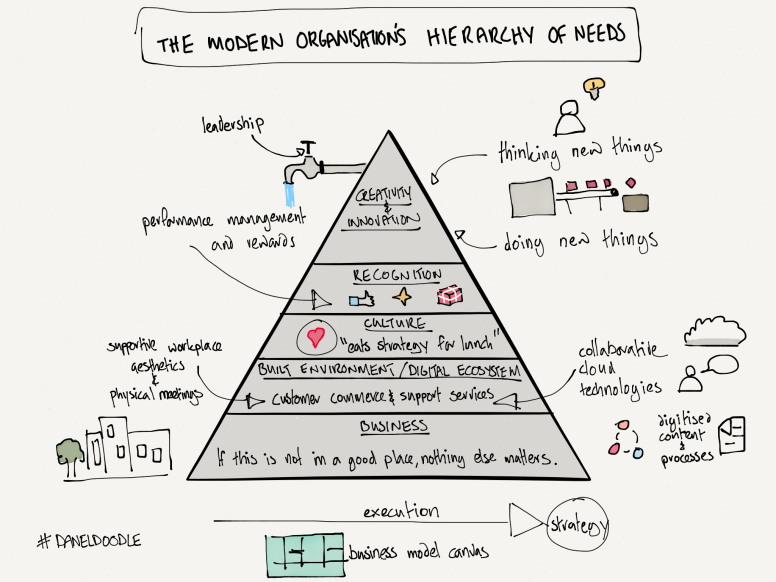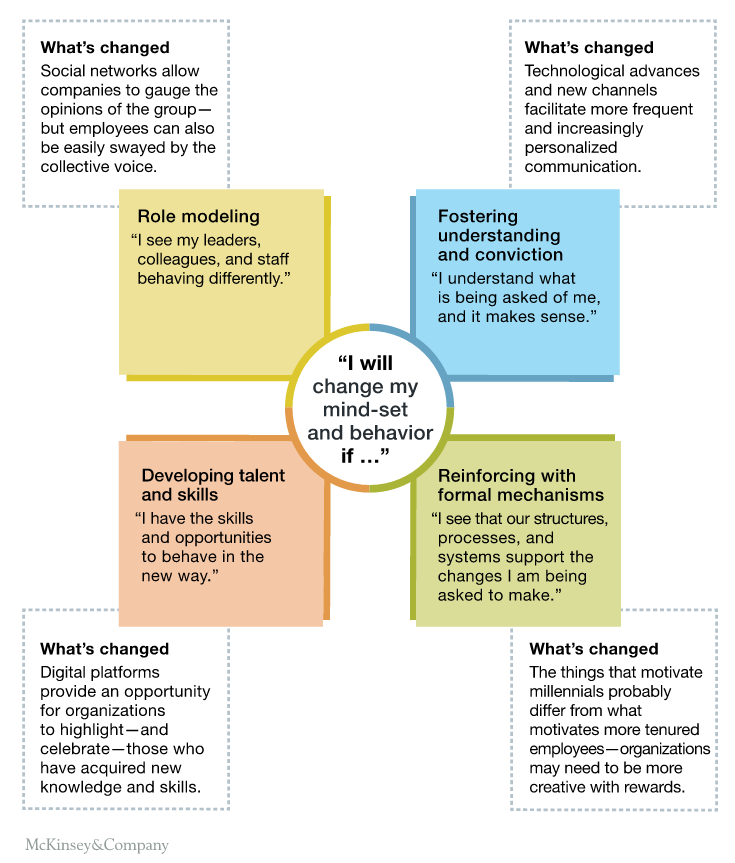-
The Modern Organisation’s Hierarchy of Needs
“This was just a fun way of framing the way the world of work is moving within a very established framework – Maslow’s Hierarchy of Needs. Each element in the hierarchy kind of speaks for itself but here are a few lines of elaboration for each.”
-
“Quels sont les modèles des entreprises du futur ? Joël de Rosnay revient sur l’art de la disruption (ou rupture) pratiqué par certaines entreprises du numérique, qualifiées de « disrupteurs », qui révolutionne le monde de l’entreprise et bouscule les modèles économiques traditionnels.”
-
Ce qui donne vie à des plateformes et des algorithmes permettant de faire parfaitement concorder l’offre et la demande.
-
- Modèle des disrupteurs :
Via des plateformes et algorithmes, les clients contribuent à créer de la valeur ajoutée > réutilisée par ces entreprises pour les revendre à d’autres, ou aux clients (avec une valeur ajoutée à laquelle ils ont eux-mêmes contribuée)
-
Ces entreprises de l’uberisation sont allées tellement vite, sont devenues tellement rentables, qu’elles nous ont « esclavagisés » en créant des monopoles : nous sommes obligés de passer par elles !
-
-
The Dirty Little Secret About Digitally Transforming Operations
“Even today, our own research confirms that only 26% of major organizational transformations succeed. Technology-based transformations involve a similar commitment: Froese confirms that helping people learn to use analytics effectively can take up to 75% of a project’s time — with the remainder going to the technical tasks of data cleaning and model design.”
-
A focused perspective. Determining where to start among thousands of potential use cases is not easy, but a balance of expected impact, technological readiness, likelihood of success, and acceptance by the organization usually provides an effective initial screen.
-
A two-speed trajectory. Setting up an entire IT architecture or automation infrastructure is akin to installing a new ERP system: a multi-year journey that often costs hundreds of millions of dollars. To avoid this roadblock, successful companies use a more agile strategy that relies on local solutions to capture value quickly, while gradually building the long-term IT and automation architecture.
-
A translator for a bigger, broader team. Capturing the digital opportunity is becoming even more of a team sport. In addition to the IT and topic experts that major IT projects required in the past, today’s efforts in complex fields such as resource-productive manufacturing or predictive maintenance need deep expertise in production processes, data science, and change management.
-
the translator. This pivotal person forms a bridge between the process and IT experts and the data scientists as new IT infrastructure is set up to enable new analytic applications
-
A commitment to helping people change. Because these innovations can have a major impact on how people work, it’s essential to anticipate people’s concerns and build a persuasive case for the new approach.
-
Remember that technology alone is not a cure-all. It’s the people applying the technology in their daily jobs who will create the additional value.
-
-
How can businesses win the hearts and minds of millennials? | World Economic Forum
“The psychological contract that traditionally bound employees to their employers has been fraying. Many of today’s workers, having experienced the pain of the economic downturn and large-scale layoffs, no longer feel as much loyalty and commitment to their organizations as they did even a decade ago. Job hopping has been described as the “new normal,†and millennials are expected to hold 15 to 20 positions over the course of their working lives.1
Meanwhile, middle management—the executives who traditionally act as a conduit for communication from the top to the bottom of companies—has been hollowed out. “
-
Almost 15 years ago, we introduced the idea that four key actions could work together to support such initiatives: fostering understanding and conviction, reinforcing change through formal mechanisms, developing talent and skills, and modeling the new roles
-
-
. Consider, for example, how modern digital communications make it easy to personalize messages, tailoring them to the needs of individuals and delivering them directly to frontline employees
-
Technology also can help identify obstacles to change, such as overconfidence in your abilities or knowledge.
-
More positively, leaders can use technology tools to celebrate skill building. For example, digital tools give organizations a creative way to show how increased effort (such as the adoption of new software or attendance at a training program) can improve performance.
-
Social platforms are more than just tools for communication and for building skills and a sense of community. They provide a sophisticated analysis that reinforces role modeling and builds up a momentum of influence
-
Today’s increasingly connected digital world provides more opportunities than ever to share information about how others think and behave.
-
-
“Lors de la conférence Viuz intitulée « Les Nouvelles Frontières du Marketing Digital » le 10 mai dernier à Paris, Antoine Dubois, Senior VP Communication & Social Media du Groupe AccorHotels et Johan Benoualid, Directeur Europe du Sud de Hootsuite ont expliqué le « Social Desk » conçu ensemble dans le cadre du programme de transformation digitale du groupe hôtelier. Actif depuis début 2016, cet ambitieux dispositif vise à encourager des salariés issus de ses 3700 hôtels afin qu’ils s’emparent des médias sociaux et se muent en ambassadeurs digitaux des différentes enseignes détenues par l’entreprise dans le monde entier. Retour d’expérience.”
-
. Il s’agit en effet d’embarquer les 3700 responsables d’hôtels du groupe et de leurs salariés volontaires à mieux appréhender les médias sociaux, amplifier la présence des marques de l’entreprise et accroître la conversation avec les communautés touristiques en ligne.
-
, AccorHotels a donc fait appel à Hootsuite afin de créer un « Social Desk », une plateforme globale où tous les hôtels du groupe peuvent accéder pour ensuite se former avec des tutoriels vidéo, disposer des contenus adéquats, s’inspirer avec des bonnes pratiques, utiliser des solutions de gestion de contenus et agir ainsi efficacement sur les médias sociaux à l’échelle de chaque pays et en fonction des spécificités locales.
-
Le groupe est passé d’une logique de centralisation à une logique de décentralisation tout en gardant un outil global permettant de coordonner les flux de contenus, de la publication, de l’engagement, des statistiques dans une seule plateforme qui possède par ailleurs une logique multilingue ».
-
l’audience du groupe AccorHotels a été multipliée par 6 sur les réseaux sociaux. Autrement dit, le groupe est passé de 4,8 millions de personnes qui le suivaient sur les réseaux sociaux à plus de 27 millions de personnes actuellemen
-


